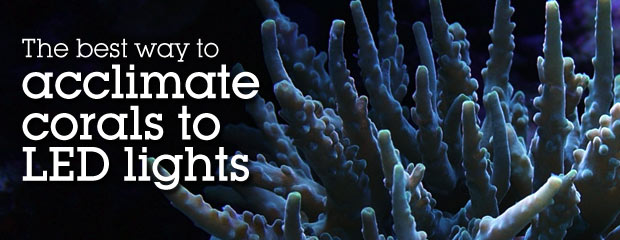
A big issue many reef hobbyists encounter when using new LED lights is coral bleaching and proper light acclimation.
Unfortunately, it's often an issue you never hear anyone talk about until you have already bleached a few corals or already made numerous trips to the local fish store or your favorite reef forum.
 Coral bleaching is when a coral loses its symbiotic zooxanthellae (what gives them color). When corals are "stressed," they often expel their zooxanthellae, leading to a lighter or completely white appearance (hence, why we call it "bleaching"). In nature, it can be caused by a multitude of factors, including:
Coral bleaching is when a coral loses its symbiotic zooxanthellae (what gives them color). When corals are "stressed," they often expel their zooxanthellae, leading to a lighter or completely white appearance (hence, why we call it "bleaching"). In nature, it can be caused by a multitude of factors, including:
- Dramatic change in water temperature
- Increased solar radiance (PAR and UV band light)
- Changes in water chemistry or salinity
- Bacterial infections
- Silt and run-off
- Herbicides, pollution and cyanide
In reef aquariums, the same factors can cause the same effect, especially an increase in light levels. Often times, switching from fluorescent light to LED is a dramatic increase in PAR, so it's very important to slowly acclimate your corals to your new lights.
We've put together this simple guide to help everyone out with acclimating their tank to a new set of lights. It doesn't matter if you are going from T5s to LEDs or Metal Halide to LEDs. Light acclimation is HIGHLY recommended!
Here are a few steps you can take to make the transition as easy as possible on you and your animals.
1) Raise your fixture. This method is best used if you have a hanging system on your lights or another way to easily move the lights higher over the tank. You will want to slowly lower your fixture over the course of 3-4 weeks.
2) Reduce your photoperiod. In essence, don't let your lights run for as long as they have been. Most hobbyists run their tank lights for 10-12 hours total. Most of us have a dusk/dawn schedule where we run only the blue or actinic lights for a couple hours before and after our daylight bulbs are used. You are probably safe to still run your dusk/dawn lighting for the same time, but you should drastically reduce the amount of time that your daylight bulbs are on. Try only running them for 4 hours now instead of the 8-9 hours that you were before. Then slowly, over a month, add one hour every week until you are back to your original schedule.
3) Use window screen or shade cloth. Just make a trip to your local hardware store or plant nursery and buy some window screen or shade cloth. You will want enough to cover the entire top of your tank with 3-4 layers of screen. You simply put the entire screen on top of your tank and remove one layer at a time every 4-5 days. If your corals seem a little stressed after you remove a layer, place it back on for 1-2 days and then try again. Overall, this should take you 3-4 weeks but in some cases can go much faster.
4) Use a dimmer. Transitioning has never been so easy! Simply hook up a dimmer and lower the light intensity. Carefully watch your corals for any bleaching or other signs of stress. You may have to implement another method mentioned above in severe cases. When your corals look healthy, you can slowly ramp up the intensity to the desired level. Again, this method should take 3-4 weeks.
No matter which method you use, ALWAYS watch your corals to see how they react. Taking your time and being patient – can and will – save your tank. No guide can replace what you are seeing happen in your tank. If corals are losing color and turning white, SLOW DOWN. Patience pays as always with reef aquariums! Take your time and you'll be amazed by the power of your new LEDs.
Information provided by

|